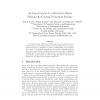Free Online Productivity Tools
i2Speak
i2Symbol
i2OCR
iTex2Img
iWeb2Print
iWeb2Shot
i2Type
iPdf2Split
iPdf2Merge
i2Bopomofo
i2Arabic
i2Style
i2Image
i2PDF
iLatex2Rtf
Sci2ools
MMSEC
2006
ACM
2006
ACM
An improvement to a biometric.based multimedia content protection scheme
A biometric-based method for multimedia content protection was recently proposed. The method relies on biometric data of the user and a layered encryption mechanism to achieve confidentiality of the multimedia content. Our analysis suggests that the method originally proposed has a few security related problems and several unnecessary performance bottlenecks. We point these out and propose corresponding security and performance improvements in order to make the scheme practical and efficient for the task it was originally designed for.
Biometric-based Method | MMSEC 2006 | Multimedia | Multimedia Content | Multimedia Content Protection |
| Added | 14 Jun 2010 |
| Updated | 14 Jun 2010 |
| Type | Conference |
| Year | 2006 |
| Where | MMSEC |
| Authors | Daniel Socek, Michal Sramka, Oge Marques, Dubravko Culibrk |
Comments (0)

